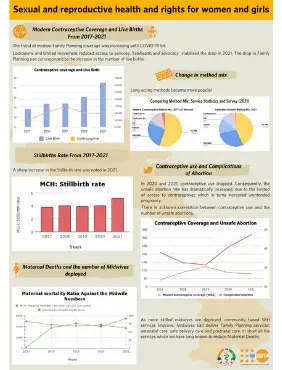The trend of modern Family Planning coverage was increasing until COVID-19 hit.
Lockdowns and limited movement reduced access to services. Telehealth and advocacy stabilised the drop in 2021. The drop in Family Planning use corresponded to the increase in the number of live births.
In 2020 and 2021, contraceptive use dropped. Consequently, the unsafe abortion rate has dramatically increased, due to the limited of access to contraceptives which in turns increased unintended pregnancy.
There is a known correlation between contraceptive use and the number of unsafe abortions.
As more skilled midwives are deployed, community based SRH services improve. Midwives can deliver Family Planning services, antenatal care, safe delivery care and postnatal care, in short all the services which we have long known to reduce Maternal Deaths.
Telehealth was tested in Luang Prabang to mitigate disruptions of essential SRMNCAH services. Regular, timely follow up of pregnant women by health worker contributed to reduced maternal mortality in the province.


